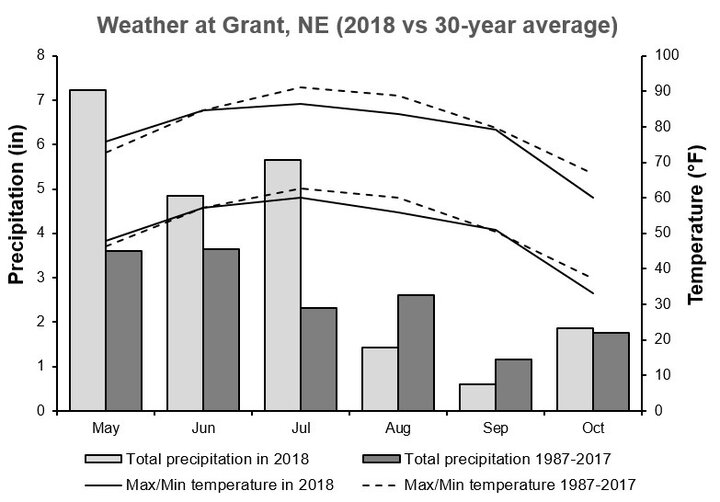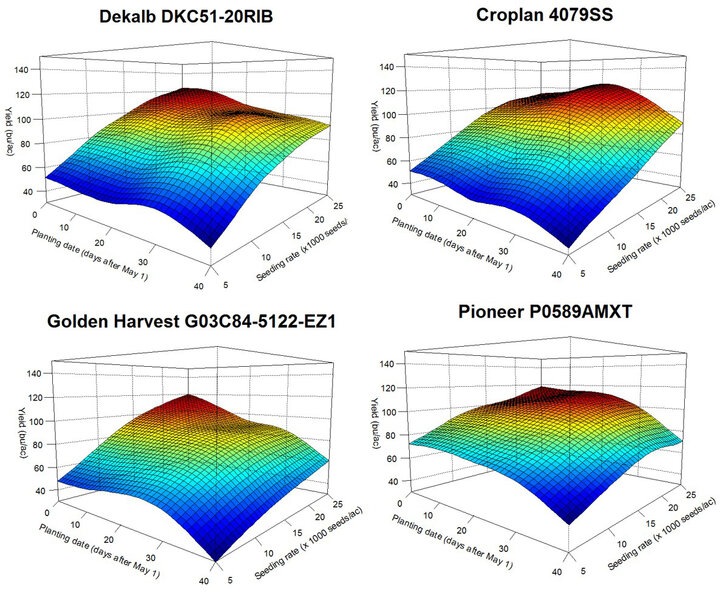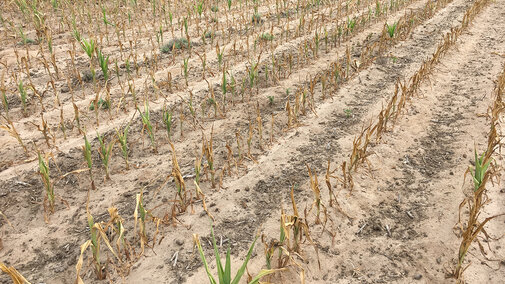Corn is a critical part of dryland crop rotations in western Nebraska and is typically grown either as continuous corn or after wheat in a three-year wheat-corn-fallow rotation. Many farmers prioritize planting irrigated acres first, often delaying planting dryland corn until after the USDA Risk Management Agency’s final planting date (May 25) for full insurance coverage.
The May 25 planting cutoff is applied across Nebraska. Many corn growers in western Nebraska perceive this policy as unfair due to the shorter growing season and often better grain yield observed in late-planted corn. During the 2017 early season drought, many farmers in Chase County lost their early-planted dryland corn (Figure 1). Others in the region reported better yield of late-planted dryland corn.
In response, this study was designed to re-evaluate the effects of planting date on dryland corn and examine whether hybrid selection and seeding rate recommendations should be reconsidered for late planting dates.
On-farm Strip Trial at Grant
| Brand | Hybrid* | Relative Maturity | Price per bag ($) |
|---|---|---|---|
| DeKalb® | DKC51-20RIB | 101 | 263.61 |
| Croplan® | 4079SS | 100 | 307.64 |
| Golden Harvest® | G03C84-5122-EZ1 | 103 | 200.00 |
| Pioneer® | P0589AMXT | 105 | 314.16 |
| * Each hybrid was planted at five planting dates (May 1-June 10) and five seeding rates (7,000-23,000 seeds/ac) | |||
A strip trial was conducted at the Henry J. Stumpf International Wheat Center at Grant during the 2018 growing season on a 75-acre field. The predominant soil type at the site was Kuma silt loam, the previous crop was corn, and the trial was managed using UNL recommended no-till practices and fertility program based on 120 bu/ac yield goal.
Four seed corn companies were contacted to provide their best performing dryland corn hybrids (Table 1) for this study. Each hybrid was planted at five planting dates (May 1, May 10, May 20, May 30, June 10) and five seeding rates (7, 11, 15, 19, and 23 thousand seeds/ac). Each combination was replicated three times and planted into a 60 ft x 150 ft strip. The middle 30 ft of each strip was harvested for yield. Marginal net return (MNR; $/ac) was calculated:
MNR = yield (bu/ac) x seed price ($3.33/bu) – seeding rate ($/ac) x seed price ($/ac)
Main Findings



- The 2018 seasonal precipitation (May-October) was 6.5 inches higher than the 30-year average, especially early in the season, leading to very good yield from early-planted corn (Figure 2, Table 2). In contrast, late season precipitation in August and September was below average, causing yield reduction in late-planted corn (Figure 2, Table 2).
- Yield penalty for planting dryland corn ranged from 0.5-1.0 bu/ac/day, depending on seeding rate (Figure 3, Table 2).
- Corn responded very well to higher seeding rates (>19,000), especially at early planting dates (early-mid May) while increasing seeding rate beyond 15,000 seeds/ac was seldom economically justified at late planting dates (Table 3, Figures 3-4).
- Corn hybrid performance varied by planting date and seeding rate (Tables 4-5). The Golden Harvest hybrid performed best (both for yield and profit) at early planting at high seeding rates. The Croplan hybrid performed well with a mid-May planting at seeding rates above 15,000 seeds/ac. The DeKalb hybrid was the most profitable at late planting dates. The Pioneer hybrid performed best with seeding rates of less than 15,000 seeds/ac, regardless of planting date.
Take-Home Messages
Based on our dryland corn data from the 2018 growing season, it is hard to argue against the current RMA statewide final planting date for full insurance coverage. However, 2018 weather patterns may have favored such results. Multi-year evaluation is needed to evaluate corn yield response to planting dates in semi-arid regions impacted by intermittent periods of drought, such as in western Nebraska.
Due to differences in seed price and responses to seeding practices, hybrid selection should be integral to plans for dryland corn production in 2019.
Previous modeling studies by Nebraska Extension Specialists Bob Klein and Drew Lyon showed that a harvest population of 12,500 plants per acre provided the best economic returns in dryland corn production in western Nebraska.
Acknowledgment
We would like to thank Justin Richardson, Nemanja Arsenijevic, and Zaim Ugljic for their efforts in conducting this field study.
| Seeding rate (seeds/ac) |
Planting date | ||||||||
|---|---|---|---|---|---|---|---|---|---|
| 1-May | 6-May | 11-May | 16-May | 21-May | 26-May | 31-May | 5-Jun | 10-Jun | |
| 23,000 | 114 | 113 | 110 | 109 | 106 | 104 | 99 | 88 | 75 |
| 21,000 | 111 | 110 | 109 | 107 | 105 | 104 | 99 | 87 | 73 |
| 19,000 | 107 | 108 | 107 | 106 | 105 | 103 | 98 | 86 | 71 |
| 17,000 | 103 | 104 | 105 | 103 | 103 | 101 | 97 | 84 | 68 |
| 15,000 | 98 | 99 | 100 | 98 | 99 | 97 | 93 | 80 | 64 |
| 13,000 | 92 | 92 | 93 | 91 | 90 | 90 | 87 | 75 | 60 |
| 11,000 | 84 | 84 | 84 | 81 | 79 | 81 | 79 | 69 | 55 |
| 9,000 | 74 | 74 | 73 | 71 | 69 | 71 | 71 | 62 | 49 |
| 7,000 | 63 | 63 | 62 | 60 | 59 | 62 | 62 | 54 | 43 |
| Hybrid | Planting date | ||||||||
|---|---|---|---|---|---|---|---|---|---|
| 1-May | 6-May | 11-May | 16-May | 21-May | 26-May | 31-May | 5-Jun | 10-Jun | |
| 23,000 seeds/ac | |||||||||
| Dekalb | 114 | 113 | 110 | 109 | 106 | 104 | 99 | 88 | 75 |
| Croplan | 110 | 111 | 113 | 119 | 123 | 120 | 111 | 99 | 85 |
| Golden Harvest | 116 | 112 | 105 | 98 | 91 | 89 | 85 | 73 | 59 |
| Pioneer | 114 | 112 | 111 | 112 | 111 | 107 | 99 | 86 | 70 |
| 21,000 seeds/ac | |||||||||
| Dekalb | 111 | 110 | 109 | 107 | 105 | 104 | 99 | 87 | 73 |
| Croplan | 108 | 109 | 111 | 116 | 120 | 117 | 108 | 94 | 80 |
| Golden Harvest | 112 | 109 | 104 | 97 | 91 | 89 | 85 | 72 | 56 |
| Pioneer | 109 | 109 | 109 | 110 | 110 | 106 | 99 | 86 | 71 |
| 19,000 seeds/ac | |||||||||
| Dekalb | 107 | 108 | 107 | 106 | 105 | 103 | 98 | 86 | 71 |
| Croplan | 105 | 106 | 109 | 112 | 116 | 112 | 104 | 89 | 74 |
| Golden Harvest | 107 | 105 | 102 | 96 | 91 | 89 | 84 | 70 | 54 |
| Pioneer | 105 | 106 | 107 | 108 | 108 | 105 | 98 | 85 | 72 |
| 17,000 seeds/ac | |||||||||
| Dekalb | 103 | 104 | 105 | 103 | 103 | 101 | 97 | 84 | 68 |
| Croplan | 101 | 102 | 104 | 107 | 110 | 106 | 98 | 84 | 68 |
| Golden Harvest | 102 | 101 | 98 | 94 | 91 | 88 | 82 | 68 | 52 |
| Pioneer | 102 | 103 | 105 | 106 | 106 | 102 | 96 | 84 | 71 |
| 15,000 seeds/ac | |||||||||
| Dekalb | 98 | 99 | 100 | 98 | 99 | 97 | 93 | 80 | 64 |
| Croplan | 95 | 96 | 98 | 99 | 101 | 98 | 92 | 78 | 62 |
| Golden Harvest | 95 | 95 | 94 | 90 | 89 | 86 | 80 | 66 | 49 |
| Pioneer | 100 | 101 | 102 | 102 | 102 | 99 | 92 | 81 | 69 |
| 13,000 seeds/ac | |||||||||
| Dekalb | 92 | 93 | 93 | 91 | 90 | 90 | 87 | 75 | 60 |
| Croplan | 87 | 88 | 89 | 89 | 89 | 88 | 84 | 71 | 57 |
| Golden Harvest | 87 | 87 | 86 | 85 | 84 | 82 | 76 | 62 | 46 |
| Pioneer | 97 | 97 | 98 | 97 | 96 | 93 | 88 | 78 | 65 |
| 11,000 seeds/ac | |||||||||
| Decalb | 84 | 84 | 84 | 81 | 79 | 81 | 79 | 69 | 55 |
| Croplan | 78 | 80 | 80 | 78 | 76 | 77 | 75 | 65 | 51 |
| Golden Harvest | 78 | 77 | 77 | 77 | 78 | 76 | 71 | 58 | 42 |
| Pioneer | 92 | 92 | 93 | 91 | 89 | 87 | 82 | 73 | 60 |
| 9,000 seeds/ac | |||||||||
| Dekalb | 74 | 74 | 73 | 71 | 69 | 71 | 71 | 62 | 49 |
| Croplan | 69 | 70 | 70 | 67 | 64 | 66 | 65 | 57 | 46 |
| Golden Harvest | 68 | 67 | 68 | 69 | 70 | 70 | 65 | 53 | 39 |
| Pioneer | 86 | 86 | 86 | 85 | 82 | 81 | 76 | 67 | 56 |
| 7,000 seeds/ac | |||||||||
| Dekalb | 63 | 63 | 62 | 60 | 59 | 62 | 62 | 54 | 43 |
| Croplan | 60 | 60 | 60 | 56 | 53 | 55 | 56 | 50 | 40 |
| Golden Harvest | 57 | 57 | 58 | 60 | 62 | 62 | 58 | 48 | 35 |
| Pioneer | 79 | 79 | 80 | 78 | 76 | 74 | 70 | 62 | 51 |
| Seeding rate (seeds/ac) |
Planting date | ||||||||
|---|---|---|---|---|---|---|---|---|---|
| 1-May | 6-May | 11-May | 16-May | 21-May | 26-May | 31-May | 5-Jun | 10-Jun | |
| 23,000 | GH* | D | C | C | C | C | C | C | C |
| 21,000 | GH | D | C | C | C | C | C | C | C |
| 19,000 | GH | D | C | C | C | C | C | C | C |
| 17,000 | D | D | P | C | C | C | C | C | C |
| 15,000 | P | P | P | P | P | P | D | P | P |
| 13,000 | P | P | P | P | P | P | P | P | P |
| 11,000 | P | P | P | P | P | P | P | P | P |
| 9,000 | P | P | P | P | P | P | P | P | P |
| 7,000 | P | P | P | P | P | P | P | P | P |
Table 5. The most profitable corn hybrids for a given planting date and seeding rate during a field study at Grant in 2018 [Dekalb DKC51-20RIB (D), Croplan 4079SS (C), Golden Harvest G03C84-4122-EZ1 (GH) and Pioneer P05889AMXT (P)].
| Seeding rate (seeds/ac) |
Planting date | ||||||||
|---|---|---|---|---|---|---|---|---|---|
| 1-May | 6-May | 11-May | 16-May | 21-May | 26-May | 31-May | 5-Jun | 10-Jun | |
| 23,000 | GH | D | D | C | C | C | C | D | D |
| 21,000 | GH | D | D | C | C | C | C | D | D |
| 19,000 | GH | D | D | C | C | C | C | D | D |
| 17,000 | GH | D | D | C | C | C | D | D | D |
| 15,000 | GH | D | D | P | P | D | D | D | D |
| 13,000 | P | P | P | P | P | P | D | D | D |
| 11,000 | P | P | P | P | P | P | D | D | D |
| 9,000 | P | P | P | P | P | P | P | D | D |
| 7,000 | P | P | P | P | P | P | P | P | P |

